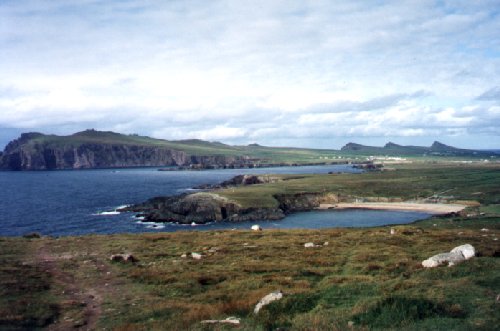|
The Dingle Peninsula is Ireland's most westerly point. It is a Gaeltacht, an area where Irish is spoken, and is also a very picturesque area. There are many sites of prehistoric and early christian remains, over 2000 of them. These include beehive huts (in Irish clocháns), on the way to Slea Head, amazingly built high on the mountainside overlooking the sea. They are surrounded by a wall at places 14ft thick. They are very well preserved and open to the public. At Milltown there are several standing stones, two are known as the "Gates of Glory" possibly erected to celebrate the legendary Fianna victory in prehistoric Battle of Ventry. Outside Ballyferriter is an ancient monastic site of the 5th or 6th century. The site was enclosed by a stone wall and contains the lower portions of bee-hive huts, an oratory, pillars and slabs with crosses on them and a corn drying kiln. The place has been recently excavated and shows what an early Christian monastery looks like. The Gallarus Oratory dates from 800 to 1200 and is the most perfectly preserved example of an oratory you are ever likely to see. There are several castles in the area. Minard castle is south -west of the village of Anascaul and was once stronghold of the Knights of Kerry. It was built in 1650 and destroyed by Cromwellian troops in 1650. Ferriter Castle ruins is situated north-west of the village of Ballyferriter. It dates from 15th century and was the birthplace of Piaras Ferriter who was the last Irish Chief to hold out against Cromwell. Before the present castle was built there was an iron age fortress here. Close by is an iron-age fort called Dún an Oír, Fort of Gold. In 1580 this was the site of a bloody massacre as 600 Irish and Spanish soldiers surrendered to the English. Dunbeg Fort, 4 miles west of Vertry is also an Iron-age fort. It is perched on a 60ft cliff that plunges to the sea below. There are earth banks, a roofed entrance, guard rooms and an underground escape passage. The Dingle Peninsular is famous these days for another reason. Fungie the dolphin. He was spotted in 1984 and has always been friendly. these days visitors flock to see him and you can take boat rides out to just see him or to swim, snorkel or scuba dive with him. He enjoys human contact, preforming tricks for the boats and swimmers and is highly intelligent as all dolphins are, becoming extra gentle with disabled people. It is also intersting to know that Ryan's Daughter was filmed in the area. In fact at Dunquin right on the head of the Peninsular, where a whole village was built as a film set. The only part that remains now is the schoolhouse. |
